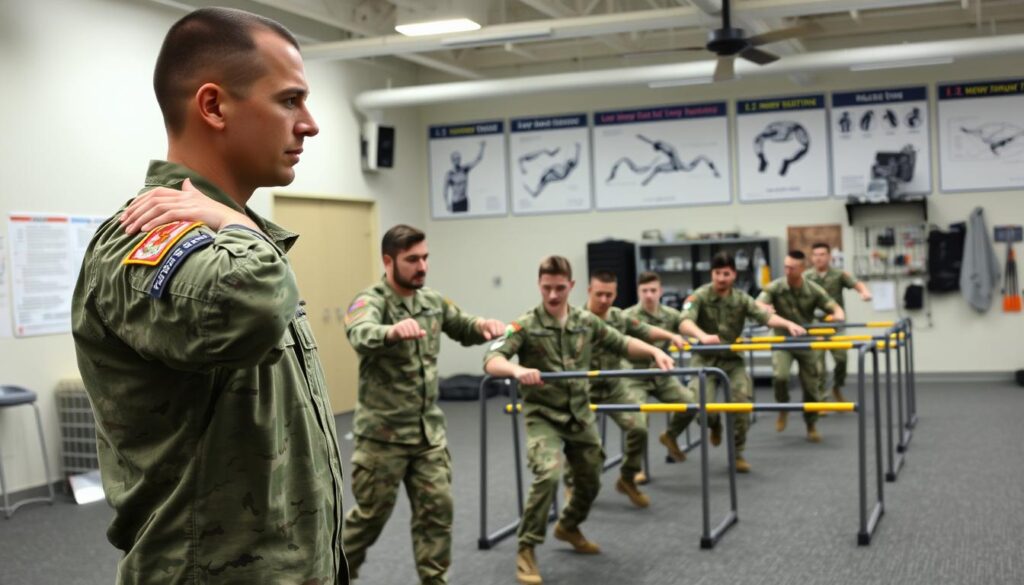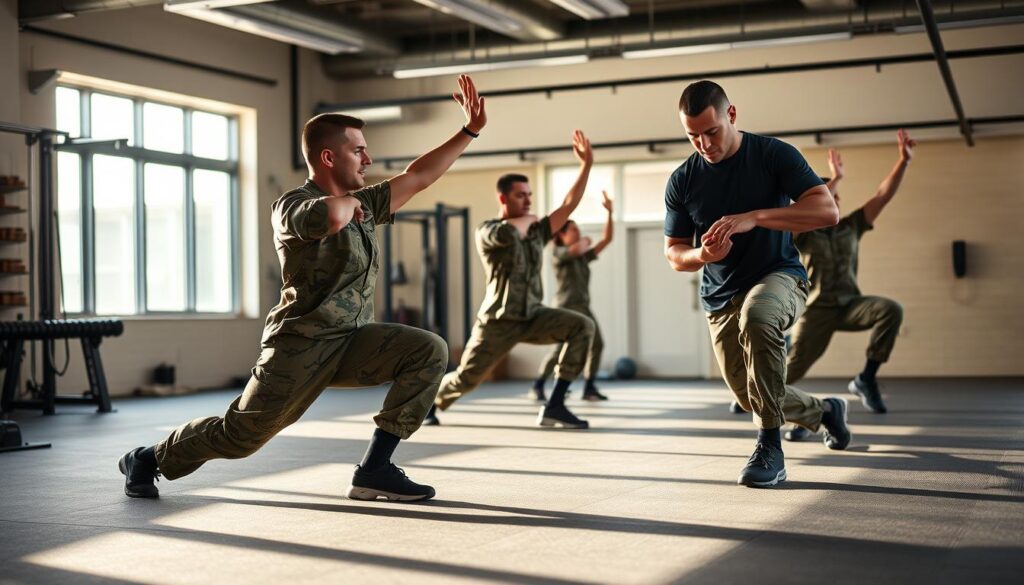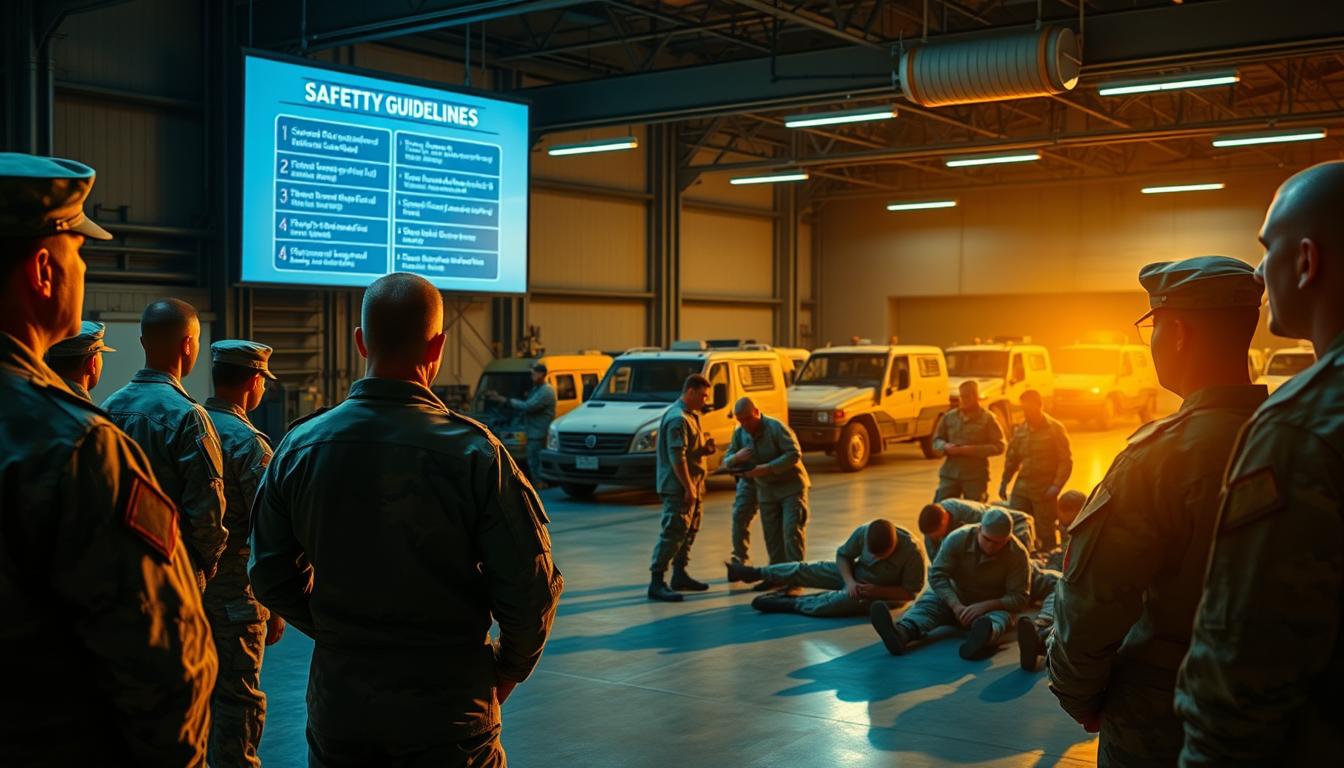Can the U.S. Army cut down on millions of lost duty days each year? This is due to non-battle injuries. The answer is yes, with the right military safety guidelines and strategies. The U.S. Army Public Health Center offers many resources on injury prevention. These include factsheets and training products to help solve this problem.
Unit leaders are key in injury prevention. They use e-Profile data to plan and track injury causes. This helps improve readiness. Also, keeping a healthy BMI, knowing injury-prone behaviors, and using proper training techniques are vital for preventing injuries.
Key Takeaways
- Effective injury prevention strategies can reduce lost duty days.
- The U.S. Army Public Health Center offers resources on injury prevention.
- Unit leaders should use e-Profile data to track and prevent injuries.
- Maintaining a healthy BMI and awareness of injury-prone behaviors are crucial.
- Proper techniques during training can significantly reduce injuries.
Understanding Common Army Injuries
It’s key to know about common Army injuries to prevent them. These injuries can affect a soldier’s performance and health. The U.S. Army Public Health Center says foot marching, running, and weight training are common causes.

Overview of Common Injuries in the Field
Army injuries often come from training and combat. Overuse injuries like stress fractures and tendonitis are common. They happen because muscles and bones get too much strain. Sprains and strains also happen a lot during training.
The U.S. Army Public Health Center found that running and foot marching injuries are common. These can be due to bad footwear, poor training surfaces, and not enough rest.
Risk Factors for Army Injuries
Many things can make Army injuries more likely. Overuse is a big one, as not resting enough can cause injuries. Other risks include bad equipment, poor training, and having had injuries before.
- Inadequate footwear or equipment
- Poor training surfaces or environments
- Insufficient recovery time between training sessions
- Previous history of injuries
Long-term Consequences of Overuse
Overuse injuries can have lasting effects. They can cause chronic pain and limited mobility. Severe injuries might even lead to medical discharge, affecting a soldier’s career and health.
To prevent injuries, the Army needs to focus on proper training, good equipment, and enough rest. Knowing about common injuries and their causes helps the Army keep its soldiers healthy and ready.
The Importance of Physical Fitness
The U.S. Army knows that physical fitness is key to injury prevention strategies for soldiers. A good fitness program helps soldiers stay strong against injuries. It includes strength training, aerobic exercise, and work on flexibility and mobility.
Creating a Balanced Exercise Routine
A balanced exercise routine is vital for fitness. The U.S. Army Public Health Center says to mix strength training, aerobic exercise, and flexibility and mobility work. This mix boosts performance and lowers injury risk.
Strength training is key for muscle building and endurance. It uses exercises that work many muscles at once. This improves strength and resilience.
| Exercise Type | Benefits | Examples |
|---|---|---|
| Strength Training | Builds muscle, enhances endurance | Squats, Deadlifts, Bench Press |
| Aerobic Exercise | Improves cardiovascular health | Running, Cycling, Swimming |
| Flexibility and Mobility Work | Enhances range of motion | Yoga, Stretching Exercises |
Strength Training for Injury Prevention
Strength training is a key part of army injury prevention techniques. Stronger muscles can handle the demands of duty better, lowering injury risk.
A good strength training program should cover all major muscle groups. Exercises like squats, deadlifts, and bench press are good. They work many muscles at once.

Benefits of Flexibility and Mobility Work
Flexibility and mobility exercises keep joints moving freely. Yoga and stretching improve flexibility, cutting down on muscle strains and injuries.
Adding flexibility and mobility work to daily routines boosts physical performance. It makes soldiers more effective in their duties.
Nutrition and Hydration for Optimal Performance
In the military, nutrition and hydration are key for performance and safety. They help prevent injuries and ensure personnel perform well.
Role of Nutrition in Muscle Recovery
Nutrition is vital for muscle recovery after hard workouts. Eating the right mix of protein and carbohydrates helps repair muscles. Protein fixes muscle tears, and carbs refill energy.
It’s best to eat a mix of protein and carbs within 30-60 minutes after working out. This helps your body recover from the workout stress.
Staying Hydrated During Training
Hydration is as important as nutrition for staying safe and performing well. Dehydration can cause poor performance, heat sickness, and injuries. It’s important to drink water all day, not just during training.
The U.S. Army Public Health Center suggests checking urine color and frequency to see if you’re hydrated. Dark yellow urine or not urinating often means you need more water.
Supplements: What Works and What Doesn’t
While a balanced diet is best, some supplements can help. For example, protein supplements can help if you can’t get enough protein from food.
But, be careful with supplements. Many aren’t tested, and their safety and effectiveness vary. Always talk to a doctor before taking any supplements.
Equipment and Gear Considerations
Choosing the right equipment is key to preventing injuries in the army. The U.S. Army Public Health Center says that the right gear is essential. It helps prevent injuries during training and operations.
Choosing the Right Footwear
Footwear is crucial for soldiers. It affects their performance and injury risk. Footwear should match the activity or terrain, offering support and cushioning.
- Consider the type of activity or terrain.
- Ensure the footwear provides adequate support.
- Choose footwear with appropriate cushioning.
According to military safety guidelines, the right footwear can lower foot injury risk. It should fit well and be suitable for the task.
Proper Use of Personal Protective Equipment (PPE)
PPE is made to protect soldiers from hazards. Using PPE correctly is key to avoiding injuries.
“The proper use of PPE can significantly reduce the incidence of injuries.”
PPE includes helmets, knee pads, and gloves. It’s important to wear PPE correctly and check its condition regularly.
| Type of PPE | Purpose | Inspection Criteria |
|---|---|---|
| Helmets | Head Protection | Cracks, Dents, Proper Fit |
| Knee Pads | Knee Protection | Tear, Wear, Proper Fit |
| Gloves | Hand Protection | Tear, Grip Integrity, Proper Fit |
Maintaining and Inspecting Gear Regularly
Regular gear maintenance and inspection are vital. They keep equipment in good shape and working right.
Regular Inspection Checklist:
- Inspect gear before and after use.
- Check for signs of wear or damage.
- Follow manufacturer guidelines for maintenance.
Following these steps helps soldiers avoid injuries. It also makes sure their gear is always ready for action.
Best Practices for Incident Reporting
Effective incident reporting is key to preventing injuries in the army. The U.S. Army Public Health Center stresses the need to report injuries quickly. This ensures soldiers get medical help fast and avoids more harm.
Prompt Reporting: A Key to Injury Prevention
Reporting injuries quickly helps prevent long-term damage. It’s a crucial part of keeping soldiers safe. It lets them get the care they need and get back to work fast.
Fostering a Culture of Safety
Creating a safe culture in the Army is vital. It encourages soldiers to report incidents and near-misses. This helps find and fix potential dangers before they cause harm.
Support and Recovery Resources
The Army offers many resources for support and recovery. These include medical care and rehab programs. With these, soldiers can heal from injuries and get back to their duties, keeping their careers and health on track.

